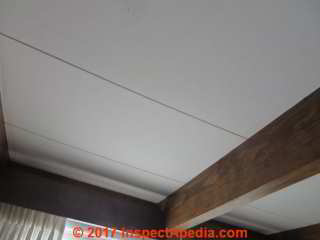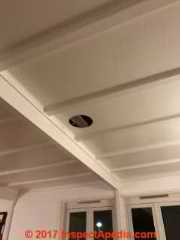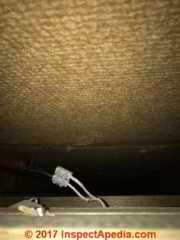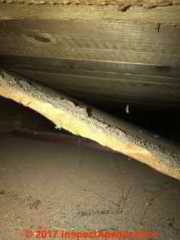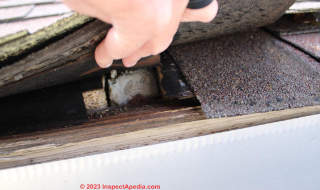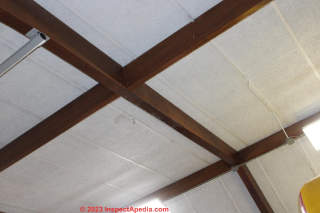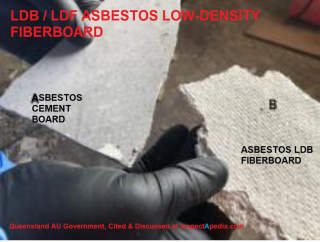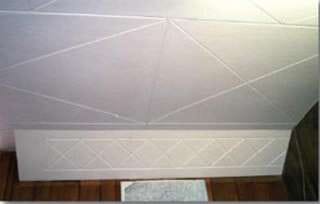 Fiberboard Building Wall & Ceilings
Fiberboard Building Wall & Ceilings
Cellulose / wood ceiling & wall board coverings
- POST a QUESTION or COMMENT about fiberboard building sheathing: how to identify fiberboard products, fiberboard uses, fiberboard, Celotex, Homasote, Insulite & other brands, fiberboard ingredients, does fiberboard contain asbestos?
Fiberboard insulating sheathing used on or in building ceilings & walls:
This article describes and provides photographs that aid in identifying fiberboard or cellulose board or wood-product insulating board sheathing materials used on building walls and ceilings, such as Homasote, Celotex, Insulite, and Masonite products.
We also answer the question about whether or not these products are likely to contain asbestos.InspectAPedia tolerates no conflicts of interest. We have no relationship with advertisers, products, or services discussed at this website.
- Daniel Friedman, Publisher/Editor/Author - See WHO ARE WE?
Fiberboard Ceiling & Wall Sheathing on Building Interiors

Fiberboard wall and ceiling panels were widely used as an interior wall covering in both raw form (brown material in our photo) in attics and basements and more-often in a finished form in the living area where a coating or painted surface gave a more-finished appearance.
Finished surface fiberboard panels are shown at the top of this page and in other examples in the article that follows.
[Click to enlarge any image]
Often we find, or used to find, fiberboard wall and ceilings in homes built in the 1920's to 1940's and without other building insulation (in the original construction).
With a few rare exceptions, fiberboard panels used on building interior walls and ceilings are a soft, 1/2" thick or thicker board made of wood - it's a cellulose product.
Fiberboard sheathing or interior fiberboard ceiling and wall panels do not contain asbestos except in the case of cross-contamination where both asbestos-containing and non-asbestos products may have been manufactured at the same site.
Fiberboard ceiling tiles were also widely used in the 1940's and 1950's, using an embossed wood or other pattern, such as the Nu-Wood product line illustrated
at SHEATHING, FIBERBOARD ASBESTOS CONTENT
The ceiling panels shown just below were used as both an insulating panel and a finished-surface below a flat roof in a home constructed in 1960 in Two Harbors, Minnesota.
Reader question: does this brown fibrous ceiling material contain asbestos? (Netherlands)
We just bought a wooden house which is built in 1948 and we came across to a material in the living room ceiling.
We are located in the Netherlands. We don't know what it is. Previous owners had a hole where they had a ceiling light hanging. We found the material in this hole. Seems like it is big tiles. Please see the pictures. - Anonymous by private email, 2/11/2017
Reply: probably not
'm not 100% certain from your photos seen so far, but to me that material looks like a wood product that we call hardboard or "masonite" - search InspectApedia.com
for MASONITE HARDBOARD if the material you are seeing is hard, or if it's soft - that is if you can push a pencil into it, it's probably a wood product or cellulose product fiberboard.
Typically hardboard used on interiors is 1/4" thick or thinner while softer fiberboard sheathing used on ceilings and walls may be 1/2" or thicker and often is covered with a finish coating and perhaps decorative groovings in more-sophisticated products.
Reader follow-up
Just to clarify where this material is hanging please see the pdf attached. I did a simple illustration to explain better. So the white ceiling you see on the picture is actually just plywood
The material I am suspicious of is just above that plywood or indeed just masonite.
There is a gap in between. 3rd and 4th images are just the tile of that suspicious material which came off. I am not sure if this is clear. I also touched this yellowish material and it is a little soft. What do you think?
Reply:
If the material is soft it's most-likely a wood product or cellulose insulating board - very similar to Masonite hardboard but thicker, softer, lighter. It was widely used as an insulating sheathing board on walls and ceilings.
We illustrate this product also
Note that I can't quite make out your photo: very yellow, fibrous material in panels may also be fiberglass insulating panels or ceiling tiles, though your other ceiling-interior photo above shows more-characteristic brown, patterned wood or cellulose board product.
Keep in mind that even if a ceiling panel contained asbestos, if the panel is covered, un-damaged, not releasing debris into the occupied space it's not much of a concern and the recommended course of action is to leave it alone.
Reader follow-up: tests found this cellulose or wood product as not asbestos.
I thought I'd give you an update on this. Last week we had a specialist checking the whole house for possible asbestos and indeed he said this is not asbestos. It is just a wood product for insulation.
Also see SHEATHING, FIBERBOARD ASBESTOS CONTENT
...
Reader Comments, Questions & Answers About The Article Above
Below you will find questions and answers previously posted on this page at its page bottom reader comment box.
Reader Q&A - also see RECOMMENDED ARTICLES & FAQs
On 2023-03-19 by InspectApedia Editor - fiberboard panels used as insulation and roof base
@Elise,
Sure, at least I'm willing to GUESS:
From the 1960's it was popular to use a thick wood- or plant-fiber based panel, often 3" thick or more, that doubled as both an insulating panel and a surface to which a roof could be applied.
(This reader's questions and photos were originally posted at
ROOF INSTALL, INSPECT, & REPAIR)
On 2023-03-19 by Elise
Can someone tell me what kind of sheathing system this is? Appears to be panels with a fiber-like material. Building was constructed around 1970 or so but unknown if this is original to the building.
...On 2021-11-09 by (mod) - what is the right way to identify or classify fiberboard products?
John Marker,
I apologize for the bad link in my earlier response.
Your post under the name John Marker is, curiously, identical in the link it offers, to a post found at our
article UNIDENTIFIED FIBERBOARD PRODUCTS posted under the name Bob Rutledge. Unfortunately duplicate posts by various pseudonyms do not reflect well on their author.
Nevertheless we provide a researched answer to your comment:
Here we seem to have tripped over a bit of confusion about identifying fiberboard sheathing products.
1. What is the Type of fiberboard ?
There is the 1st question of type of fiber board such as HDF, MDF, and LDF three different densities or hardness has of otherwise a similar material. Your question suggests these as the right way to identify hardboard.
See DEFINITIONS, ENGINEERED WOOD HDF LDF LVL MDF MDO OSB where we describe the differences between HDF, LDF, MDF, etc.
Also see SIDING HARDBOARD IDENTIFICATION & CLAIMS where we describe different hardboard brands, product failures, warranties
But by "identify hardboard" (or MDF or LDF) many readers are asking something else. They want to identify the brand or product or they want to know the constituents of the product and they want to know if it contains asbestos.
2. What is the Brand or manufacturer of fiberboard ?
Separate from the fiberboard type question is that of identifying the specific brand of fiber board.
At FIBERBOARD SHEATHING IDENTIFICATION you will find a complete list of fiberboard manufacturers, past and present, along with visual clues that can help identify specific brands.
3. What is the Asbestos content in fiberboard ?
Separate from the questions above is whether or not any fiberboard sheathing or siding, basically a plant product, contains asbestos: to which the answer is generally no with rare exceptions principally from cross-contamination.
At SHEATHING, FIBERBOARD ASBESTOS CONTENT you will find an answer to that question along with explanation and citation of expert sources.
Also see HARDBOARD Masonite™-like INGREDIENTS
The articles in this series address all of those questions.
Using our reply to your identical post under the name Bob Ruteledge
at UNIDENTIFIED FIBERBOARD PRODUCTS we continue:
@Bob Ruteledge,
Thank you for the question on asbestos in fiberboard and for the reference you cited.
Your reference to Kollmann's article does not address your asbestos question.
In the Recommended Articles above you will see a thorough exposition of the various types of fiberboard, such as HDF, MDF, LDF, and the properties of each;
In the article on this page, by "identification of fiberboard" we refer not to the type but rather to its brand or manufacturer, though fiberboard type can be one of the data points in that determination.
Your Kollman citation is described by the following article in Principles of Wood Science & Technology:
- Kollmann, Franz FP, Edward W. Kuenzi, and Alfred J. Stamm. FIBERBOARD [PDF] In Principles of Wood Science and Technology, pp. 551-672. Springer, Berlin, Heidelberg, 1975. - retrieved 2022/03/18 original source: https://link.springer.com/chapter/10.1007/978-3-642-87931-9_6
Abstract
There are various types of fiberboard1, and unfortunately the terminology is not yet internationally standardized. Neverthelesss, one fundamental definition generally is recognized (FAO, 1958/1959, p. 4):
“Fiberboard is a board generic term encompassing sheet materials of widely varying densities manufactured from refined or partially refined wood fibres or other vegetable fibres. Bonding agents and other materials may be incorporated in the manufacture of the board to increase strength, resistance to moisture, fire or decay or to improve some other property.” In the technical sense the ISO-definition is more precise:
“Sheet material generally exceeding 1.5 mm in thickness, manufactured from ligno-cellulosic fibers with the primary bond from the felting of the fibers and their inherent adhesive properties. Bonding materials and/or additives may be added”.
Excerpt:
The origin of wood fiberboard goes back to Japan where as early as in the 6th century B. C. heavy papers were used for the construction of walls for small houses. In Europe a patent was granted to the British inventor Clay in 1772 for the application of "papier mache" (Neu88er, 1957) not only for use in dwellings, furniture, doors, but also for carriages.
The idea of using the new material for big stiff building elements was evident. Since the middle of the 19th century, the proposals for use of fiberboards have greatly increased. More than 200 patents were issued in this field between 1858 and 1928 (Rossmann, 1928), more than 600 patents until1957 (Neusser, 1957).
In spite of these early developments the actual fiberboard industry started near the beginning of the 20th century in England and in the U.S.A. The development up to 1926 was rather sporadic and without a remarkable increase in capacity.
Note in that author's own abstract the phrase "ligno-cellulosic fibers " - that means plant-based fibers.
"Lignocellulosic fiber is a scientific name that refers to natural fiber, because all plant fibers are constructed by few constituents (cellulose, hemicelluloses, and lignin). Most of plant fibers contain 50%–70% of cellulose ..." - sciencedirect.com 2021/11/07
Also see
- Kollmann, Franz FP, Edward W. Kuenzi, and Alfred J. Stamm. Principles of wood science and technology: II wood based materials. Springer Science & Business Media, 2012.
Asbestos is a mineral, not a plant.
Asbestos is indeed un-common in any fiberboard products but there are exceptions, such as by rare but known cross-contamination, as we describe at
SHEATHING, FIBERBOARD ASBESTOS CONTENT
You will want to read that article.
On 2021-11-08 by john marker [pseudonym] - the best factor for classifying fiberboard is the density
AUTHOR: john marker (no email)
COMMENT: Perhaps, the best factor for classifying fiberboard is the density. This is internationally recognized. There is a rather simple difference between pressed and
not pressed sheets hut the range of qualities is wide and there is an overlapping.
Another point which should be taken into consideration is the fact that wood
fibers are blended occasionally with mineral fibers (such as asbestos), plastics
and with other chemical additives. Some half-hard fiberboard contain no less
than 20% of thermoplastic bonding agents.
[Poster's promotional link to an article by Kollman et als is deleted but cited in our reply above - Ed.
]
So does this mean that an old fiberboard ceiling or wall from 50s or 60s could have asbestos added in it?
On 2021-11-02 by Inspectapedia Com Moderator (mod)
@Susie smith,
Got it.
Indeed some white or gray-colored MDF or other board products contained asbestos. You'll want to treat yours as "PACM" - presumed asbestos containing material - until you've tested a sample.
On 2021-11-02 by Susie smith
@inspectapedia.com.moderator, These board products are visibly different in colour (whitish gray throughout) than cellulose-based or plant-fibre-based fiberboard products (tan or brown in colour
This is what I'm talking about as you are referring me to this link about this type of fiberboard as mine was brownish color.i saw no white other than the paint and it was in a mobile home for ceilings
On 2021-11-02 by inspectapedia.com.moderator (mod)
@Susie smith,
No, those are not our words.
I recommend that you look at the suggested articles above.
On 2021-11-02 by Susie smith
@inspectapedia.com.moderator, so I'm other words if its not white or looks like the cement kind it should not have asbestos as the board in the link looks more like drywall
On 2021-11-02 by inspectapedia.com.moderator (mod)
@Susie smith,
Usually not but possibly; see
LOW DENSITY FIBERBOARD ASBESTOS PRODUCTS - Watch out: occasionally LDF contains high levels of asbestos
On 2021-11-02 by Susie smith
Asbestos, plaster of Paris, clay, turpentine, paraffin wax, or other materials were added to some mixes to improve fire resistance and produce other desirable qualities such as stiffness, hardness, smooth surfaces, increased strength, or durability
So does this mean that old 50s and 60s ceiling made out of the fiberboard type stuff could have asbestos added?
On 2021-09-28 by inspectapedia.com.moderator (mod)
@Julie,
The use of asbestos in building and other products was never restricted by product dimensions, weight, or other such parameters.
On 2021-09-28 by Julie
When you say ceiling tiles,are you meaning any size ceiling board,panel,sheet or just the smaller square type?
On 2021-08-25 by inspectapedia.com.moderator (mod)
@Julie,
Some paints contained asbestos, as reinforcing fibers or fillers, particularly paints intended for heat or fire resistance or some used as waterproofing coatings such as foundation paints.
The practical hazard from ALL of these materials comes when they are disturbed.
See CEILING PAINT TEXTURED ASBESTOS
Also, Julie you could really help me out here - by trying some of your questions in the on-page search box that searches this website.
That will let me know - through you - if we are actually missing information you need, or if we need to make it easier to find or to read, and it'll let me otherwise concentrate on research.
Largely provoked by your discussion I spent a good part of today adding some new material you might like at
LOW DENSITY FIBERBOARD ASBESTOS PRODUCTS - Watch out: some LDF contains high levels of asbestos
https://inspectapedia.com/structure/Fiberboard-Sheathing-Asbestos.php#LDFAsbestos
When you read this be sure you notice how easily you can distinguish this asbestos product from other plant-based low density fiberboards.
On 2021-08-25 by julie (no email)
Re-posting lost comment
AUTHOR: julie (no email)
COMMENT: @inspectapedia.com.moderator, ok that is more easily understood and what about paints down the years as if people repainted the fiberboard ceiling,could the paints contain asbestos?
On 2021-08-25 by inspectapedia.com.moderator (mod) - is there a meaningful risk of asbestos in fiberboard ceilings ?
@julie,
Yes you make a fair point, taken from our own data; however before getting too worried about your fiberboard ceiling - if that's what we even have in this case - you'd need to identify your ceiling as Celotex; It's not highly likely: mostly you'll find that product used as exterior building sheathing, and it looks quite different, often black or very dark, and not easily painted.
Start by making sure we know what your ceiling is.
See
FIBERBOARD SHEATHING IDENTIFICATION
then see
On 2021-08-24 by julie - possible asbestos in some Celotex products
@inspectapedia.com.moderator,
Asbestos was used in some Celotex products and/or may appear in some Celotex products such as cellulose-based insulating board depending on when and where the product was manufactured.
On that basis, if the age of a Celotex™ ceiling is in that range it would be prudent to treat it as PACM.[9] Confirmation of asbestos content use & dates pending - Ed.]
so i wonder about this,if mine was this brand fiber board
On 2021-08-24 by inspectapedia.com.moderator (mod)
@julie,
For most circumstances there's not an asbestos worry: fiberboard is a cellulose or plant-based product. It is not an asbestos product.
There was some concern for cross-contamination by asbestos for some product runs at certain manufacturers;
See details at FIBERBOARD SHEATHING INGREDIENTS
a quick search of InspectApedia.com using the on-page search box for "asbestos in fiberboard"
finds
SHEATHING, FIBERBOARD ASBESTOS CONTENT
In that article, in discussing the claim by some unidentified folks that some Celotex fiberboard contained asbestos, we report:
There was some question, not substantiated by any research I could find, that because some wood fiber board products may have been made at the same site where asbestos-containing materials had been used, that there may have been some cross contamination; that theory has not been supported by research articles that I've found nor by lab tests yet provided to us.
We continue to research that question and if you have found ANY authoritative source with actual information, please let me know and give me the reference for our review.
Then you should also read.
Watch out: And your final reading assignment for today - until another - most-welcome - question is
OTHER PEOPLE's MONEY
Where you'll read our opinion that if you press someone for an absolute guarantee in a world where that's not reasonable, it's going to cost you money - money that you would probably not spend if you were familiar with the topic.
On 2021-08-24 by julie - so can you guarantee there is zero chance of asbestos being mixed into my ceiling material?
@inspectapedia.com.moderator,
so if a ceiling was made of a fiberboard or wood product in the 50s then there would be no chance of asbestos being mixed in it as some things ill read says it was mixed in some fiberboard
On 2021-08-24 by inspectapedia.com.moderator (mod)
@julie,
No I don't think I said that and I surely don't think that.
On 2021-08-24 by julie
@inspectapedia.com.moderator,
so basically what your saying is its never been found in whole sheet or large panels of a ceiling other than drywall material or the square tiles. i dont believe they even put drywall in mobile homes in the 50s.
mine appeared to be something other than drywall or small tiles and mine wasnt long skinny panels either,more like a large panel of some sort.im thinking more toward the fiberboard but i have read where asbestos was sometimes added to fiber boards.
thats where im getting confused
On 2021-08-23 by inspectapedia.com.moderator (mod)
@julie,
I really would like to be more helpful but from just your text I have no idea what we are looking at. If your ceilings are made from a wood product fiberboard they would not contain asbestos. If your ceilings are plastic they would not contain asbestos.
At this point we don't know what's on your ceilings; and if it's fiberboard we don't know which product.
If your ceilings are made from drywall or some ceiling tiles any of which were manufactured in the US before 1986 then it's possible that they contain asbestos.
On 2021-08-23 by julie
no it appeared to be some wood or board material,we had a leak and removed it and it didnt appear to be white like drywall or sheetrock material. So im wondering if it was known for asbestos to be in large ceiling panels or boards of whatever mobile home manufacturers installed those days
On 2021-08-22 0 by samie - asbestos in a 1950s mobile home ceiling ?
would asbestos be in a 1950s mobile home ceiling.the ceiling is not tiles,it is a panel or board material maybe fiber board
On 2021-05-29 by (mod)
@julie,
Possibly if someone put drywall or gypsum board on the ceiling.
On 2021-05-29 by julie
would asbestos be in a 1950s mobile home ceiling,not small tiles but appears to be some board material?
On 2020-05-03 - by (mod) -
I don't recommend trying to soften ceiling tiles in order to make it easier to nail them.
The problem is that the tile will simply disintegrate and fall apart. However you do need to use a nail that is sufficiently fine or small in diameter and yet long enough to shoot through the tile. Usually people use a stapler.
On 2020-05-03 by Ganiyu Akintayo
I need help on how to soften ceiling board. I bought Kalsi Nigerite 4ft x 4ft size some large PC's about 3 years but some leftovers to be used now. But when nail is used to tack the edges,it breaking? It's too hard. What can I do? I need to use them for some ceiling cover in my extra rooms
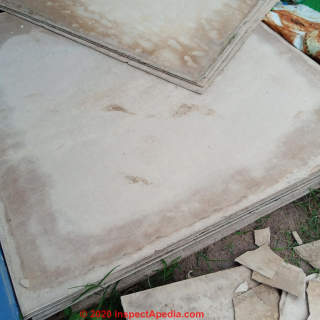
On 2019-10-28 - by (mod) - asbestos in foam fiber ceiling panels?
Unfortunately I don't think we can tell a brand or product name from a smooth White fiberboard ceiling panel. What is the concern in the roofers case?
If it's asbestos you can address the question either by having a sample tested or by noting the edge of the house or ceiling, or by making sure that the materials going to be undisturbed in the first place. If it's something else we'll have to hear the specifics.
The ceiling panel photo that you copied from our website is a very thick fiberboard panel that was used to form both a flat roof deck as well as the interior finished surface in a 1960s home constructed in northern Minnesota.
On 2019-10-28 by Tyler
Hello, I have a foam/ fiber type ceiling that is in the attached photo. Do you have an idea to the brand or style. I am getting the roof replaced and the roofer is nervous.
Thank you
Tyler
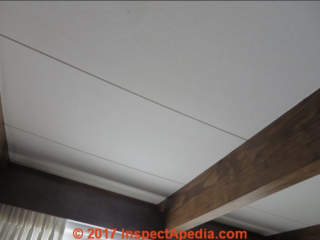
On 2019-04-12 - by (mod) -
Sorry, no Roger. It would be helpful to know the age of the material or at least the building; that way we can probably find the most-likely candidate producing firms. I think we're looking at a pre-fab insulated ceiling panel / roof decking in a flat or low slope building. Right?
We have a companion article to this page - at FIBERBOARD SHEATHING IDENTIFICATION
If I can find the panel in your photo I'll add that information here and there .
Perhaps other readers will recognize the panels.
On 2019-04-11 by Roger Hankey
Do you recall the name of this soffit panel or manufacturer
IMAGE LOST by older version of Clark Van Oyen’s Comments Box code - now fixed. Please re-post the image if you can. Sorry. Mod.
On 2018-06-26 - by (mod) -
Steven
I'm sorry but we have to reply with some questions.
What panel. What size. What wait. And what's the condition of the fiberboard surface?. Certainly itv's in general, a soft material and I would not trust it to hold something heavy there just adhesive alone .
On 2018-06-26 by Steven
How well adhesive hold a panel to the fiber board
On 2017-08-29 by Anonymous
Will sheetmetal roofing screws hold the roof on, if it they are sunk into the material about 1 1/4 inch depth. Roofer tells me I need to add plywood to the entire roof first, and I say that the roofing deck material already on there is made so it does not require any additional weight/plywood sheets. Thanks.
On 2017-08-29 by stevo
Hi. I have a ceiling exactly like your 3rd pic from the top........2 x 8ft x 2" sheets placed over the beams in my 1950 renovation project house. Some leaking has occurred and I want to replace some of the panels. Do you know what that material is? Who is mfg?
I talked with Homasote and they said they have EasyPly roof deck to substitute.
But, since I am not sure, I am wondering if you know if EasyPly will work, and if so, that I can have a standing seam metal roof to be attached directly to this roofing material like the one in your picture above.
...
Continue reading at LOW DENSITY FIBERBOARD ASBESTOS PRODUCTS or select a topic from the closely-related articles below, or see the complete ARTICLE INDEX.
Or see these
Recommended Articles
- HARDBOARD Masonite™-like INGREDIENTS
- SHEATHING, FIBERBOARD
- CANEBOARD PANELS
- CARDBOARD CORRUGATED FIBERBOARD
- CELOTEX HISTORY & PRODUCTS
- DEFINITION of FIBERBOARD SHEATHING
- HISTORY of FIBERBOARD INSULATING SHEATHING
- HOMASOTE HISTORY & PRODUCTS
- SYNONYMS for FIBERBOARD SHEATHING
- FIBERBOARD CEILING & WALL COVERINGS
- FIBERBOARD MANUFACTURERS & BRAND NAMES
- FIBERBOARD PANEL REPAIR
- FIBERBOARD PLASTER BASE SYSTEMS
- FIBERBOARD ROOF SHEATHING
- FIBERBOARD SHEATHED WALL BRACING
- FIBERBOARD SHEATHING ASBESTOS CONTENT
- FIBERBOARD SHEATHING INGREDIENTS
- FIBERBOARD SHEATHING FIRE RATINGS
- FIBERBOARD SHEATHING IDENTIFICATION
- FIBERBOARD SHEATHING INSECT DAMAGE
- FIBERBOARD SHEATHING MOLD CONTAMINATION
- FIBERBOARD SHEATHING MSDS
- FIBERBOARD ROOFING & FIBER-WOOD ROOFING
- FIBERBOARD PROTECT from WATER
- FIBERBOARD SOUND INSULATION
- LOW DENSITY FIBERBOARD ASBESTOS PRODUCTS - Watch out: some LDF contains high levels of asbestos
- SHEATHING FIBERBOARD CONSTRUCTION
- SIDING HARDBOARD IDENTIFICATION & CLAIMS
- SUNDEALA BOARD COMPOSITION & HISTORY
- SHEATHING, EXTERIOR PRODUCT INDEX
Suggested citation for this web page
FIBERBOARD CEILING & WALL COVERINGS at InspectApedia.com - online encyclopedia of building & environmental inspection, testing, diagnosis, repair, & problem prevention advice.
Or see this
INDEX to RELATED ARTICLES: ARTICLE INDEX to BUILDING INTERIORS
Or use the SEARCH BOX found below to Ask a Question or Search InspectApedia
Ask a Question or Search InspectApedia
Try the search box just below, or if you prefer, post a question or comment in the Comments box below and we will respond promptly.
Search the InspectApedia website
Note: appearance of your Comment below may be delayed: if your comment contains an image, photograph, web link, or text that looks to the software as if it might be a web link, your posting will appear after it has been approved by a moderator. Apologies for the delay.
Only one image can be added per comment but you can post as many comments, and therefore images, as you like.
You will not receive a notification when a response to your question has been posted.
Please bookmark this page to make it easy for you to check back for our response.
IF above you see "Comment Form is loading comments..." then COMMENT BOX - countable.ca / bawkbox.com IS NOT WORKING.
In any case you are welcome to send an email directly to us at InspectApedia.com at editor@inspectApedia.com
We'll reply to you directly. Please help us help you by noting, in your email, the URL of the InspectApedia page where you wanted to comment.
Citations & References
In addition to any citations in the article above, a full list is available on request.
- [1] Homasote® Company, 932 Lower Ferry Road, West Trenton, NJ 08628-0240 Tel: 800-257-9491 Ext 1332, or from outside the U.S. call 609-883-3300. Website: http://www.homasote.com/ , Email: Sales@homasote.com.
- Thanks to Homasote CEO Warren Flicker for technical review and comment on this article.
- Mark Cramer Inspection Services Mark Cramer, Tampa Florida, Mr. Cramer is a past president of ASHI, the American Society of Home Inspectors and is a Florida home inspector and home inspection educator. Mr. Cramer serves on the ASHI Home Inspection Standards. Contact Mark Cramer at: 727-595-4211 mark@BestTampaInspector.com
- John Cranor [Website: /www.house-whisperer.com ] is an ASHI member and a home inspector (The House Whisperer) is located in Glen Allen, VA 23060. He is also a contributor to InspectApedia.com in several technical areas such as plumbing and appliances (dryer vents). Contact Mr. Cranor at 804-873-8534 or by Email: johncranor@verizon.net
- [2] Celotex Corporation, PO Box 31602, Tampa FL 33631, with offices in Atlanta, Chicago, Cincinnati, Dallas, Oakland and Philadelphia, and plants in six U.S. States is headquartered in Tampa, FL. Celotex is a national manufacturer of residential and commercial building materials. Website: www.celotex.com Tel: 800-CELOTEX
"Insulation Selector Guide", Celotex Corporation, web search 6/29/12, original source: http://www.silvercote.com/PDF/ThermaxInsulSelectorGuide.pdf, [copy on file as CelotexThermaxInsulSelectorGuide.pdf ]
"Celotex Blue Ridge Fiberboard", SturdyBrace®, produced by Blue Ridge Fiberboard Inc., 250 Celotex Dr., Danville VA 24541, product literature, web search 6/29/2012, original source: blueridgefiberboard.com/pages/sturdybrace.php, [Copy on file as Celotex_BlueRidge_SturdyBrace.pdf].
MSDS: original source: blueridgefiberboard.com/pages/sturdybrace/pdfs/SturdyBrace-msds-br.pdf
"Guide Specifications: SturdyBrace® Structural Fiberboard Wall Sheathing", 6/29/12, original source: blueridgefiberboard.com/pages/sturdybrace.php [Copy on file as SturdyBrace-guidespecs.pdf] - [3] Douglas Leen, Petersburg AK 99833, contributed the photograph of insulating board scraps from roof insulation removed from a building. Dr. Leen provides such a wide range of services, collectables, and historical information about the Northwest that a succinct description is difficult: flying dentist goes anywhere, antique forestry posters, historic campers, the tugboat Katahdin, in Alaska, Washington, and Wyoming. Mr. Leen can be contacted at mail@dougleen.com or at 907-518-0335
- [4] Georgia Pacific: information about DensGlas gypsum board building sheathing can be found at the company's website at gp.com/build/product.aspx?pid=4674
- [5] "Roof Shingle Tear-Off Procedure for Homasote Products", PDF document, Homasote Co., 932 Lower Ferry Road, West Trenton, New Jersey 08628-024, U.S.A. 800-257-9491 website: at www.homasote.com
- [6] Thermafiber, Inc., (now a division of Owens Corning®) at Thermafiber, Inc., 3711 Mill Street, Wabash, IN 46992, Tel: 888-834-2371 (U.S. & Canada) - 260-563-2111 Website: www.thermafiber.com or Thermafiber technical services at 888-834-2371 (U.S. & Canada) ; Phone: 260-569-0801, Fax: 260-563-8979 or Email: technicalservice@owenscorning.com
- [7] Weaver: Beaver Board and Upson Board: Beaver Board and Upson Board: History and Conservation of Early Wallboard, Shelby Weaver, APT Bulletin, Vol. 28, No. 2/3 (1997), pp. 71-78, Association for Preservation Technology International (APT), available online at JSTOR.
- [8] Pittsburgh Press, "Yesterday - in costly homes alone, Today even the simplest home can have this hidden comfort", The Pittsburgh Press, 19 April 1925, classified ads section. Web search 6/22/12, [Copy on file as Celotex_Ad_023_PP.jpg and more]
- [9] pending research
- [10]
Patents pertaining to building insulation & insulating board, Celotex & Insulating Board type products
- "Sound absorbing board for walls and ceilings", Patent No. 1,554,180, issued to W.S. Trader, September 15,1925, first disclosed a wallboard constructed from "Celotex", a felted mass of strong bagasse fibers, so compacted as to be capable of use as an artificial lumber in that it can be sawed and nailed, and has sufficient strength in many cases to be substituted for lumber. That same patent mentions "Insulite", a building board made from wood pulp tailings and which likewise has a porous fibrous body portion and which is possessed of considerable strength so that the same can be nailed, etc. Celotex was preferred as an insulating material because its internal cells produce a sound-deadening insulating effect.
- "Method and apparatus for drying moving material", Treadway B. Munroe et als, assigned to Dahlberg & Co., U.S. Patent No. 1,598,980, 7 September 1926, described a method and apparatus for drying sheets of artificial heat insulating lumber, known on the market as Celotex, improving the original process.
- "Reenforced composition board", Treadway B. Munroe et als, U.S. Patent No. 1,578,344, 30 March 1926
- "Insulating Structural Board", U.S. Patent 2,159,300, Armen H. Tashjian et als, assigned to William B. Miller, Lakewood OH, 23 May 1939, describes insulating structural boards of laminated construction for use as roof or floor slabs, and refers to "Standard insulating fiber boards, such as "Celotex", "Masonite", "Insulite", etc. that had excellent insulating properties but have relatively slight structural strength in flexure or bending under load, hence are not and cannot be used as structural slabs for load sustaining purposes, as roof or floor slabs, for example. [Adding structural strength ran into the problem of reducing the insulating value of the product.]
- "Sound-absorbing chamber", Treadway B. Munroe et als, U.S. Patent No. 1,705,778, 19 March 1929 (using Celotex to construct a sound deadening chamber.
- "Method of and apparatus for drying moving material", U.S. Patent 2,376,612, Carl G. Muench, New Orleans, assigned to Celotex Corporation, described a method and apparatus for drying sheets of artificial heat insulating lumber, preferably formed by the felting of bagasse fiber along with other materials necessary to make a satisfactory structural fiber board. 22 May 1945
- "Sound-absorbing board for walls and ceilings," U.S. Patent 1,554,180, Sept. 15, 1925, Wilber S. Trader, assignor to Dahlberg & Company, Chicago IL. described an interior-use sound insulating product.
- [11] "Insulite Co. v. Reserve Supply Co.," 60F.2d 433 (1932), Circuit Court of Appeals, Eighth Circuit, July 26, 1932. Web Search t/23/12. Quoting:
Rabbeted joints in material to which plaster or other material is applied are found in the Jones patent, No. 886,813. In this patent the composition is made up of plaster of paris, cement, or other like substance, combined with hair, wood fiber, sawdust, wool, wood shavings, excelsior, straw, or similar substances. The length of the lath covers three joists instead of four. The boards are arranged in staggered relation to each other and the joints are shiplapped. The specification states that after the boards or blocks are placed in position they may be covered with wallpaper or other similar material, which, of course, would include plaster.- "Machine for perforating Insulite Boards", U.S. Patent No. 1,306,283, Patented 10 June 1919, John K. Shaw, inventor from Minneapolis MN, describes improvements for machines for perforating Insulite Boards.
- "Before you Build write for this mailing piece and a sample of Insulite", [advertisement], The Literary Digest, 13 September 1940.
- [13] "Separating the Fiber of Wood", A.S. Lyman, U.S. Patent No. 21,077, 3 August 1858
- [14] Standards pertaining to fiberboard insulating sheathing:
- ASTM C 208-95 (2001) – Standard Specification for Cellulosic Fiber Insulating Board. Type IV Grade 2 (Structural Wall Sheathing).
- ASTM C 846-94 (2003) – Application of Cellulosic Fiber Insulating Board for Wall Sheathing.
- ASTM D 1554 - Definitions of terms Relating to Wood Based Fiber and Particle Panel Materials.
- ASTM E-72 (1997)- Standard Method for Conducting Strength Tests of Panels for Building Construction.
- ANSI /AHA - A194.1, Cellulosic Fiberboard.
- U.S. Department of Commerce: PS57-73, Cellulosic Fiber Insulating Board
- A.F.A. (2003): Fiberboard Sheathing test results
- [15] "Properties of insulating fiberboard sheathing", Forest Products Laboratory (U.S.) Luxford, R. F. (Ronald Floyd), 1889 (1960), original report 1955, citation:hdl.handle.net/1957/2489, web search 6/29/12, original source: http://ir.library.oregonstate.edu/xmlui/handle/1957/2489
- BASEMENT MOISTURE CONTROL [PDF] U.S. Department of Energy
- Building Failures, Diagnosis & Avoidance, 2d Ed., W.H. Ransom, E.& F. Spon, New York, 1987 ISBN 0-419-14270-3
- Building Pathology, Deterioration, Diagnostics, and Intervention, Samuel Y. Harris, P.E., AIA, Esq., ISBN 0-471-33172-4, John Wiley & Sons, 2001 [General building science-DF] ISBN-10: 0471331724 ISBN-13: 978-0471331728
- Building Pathology: Principles and Practice, David Watt, Wiley-Blackwell; 2 edition (March 7, 2008) ISBN-10: 1405161035 ISBN-13: 978-1405161039
- Design of Wood Structures - ASD, Donald E. Breyer, Kenneth Fridley, Kelly Cobeen, David Pollock, McGraw Hill, 2003, ISBN-10: 0071379320, ISBN-13: 978-0071379328
This book is an update of a long-established text dating from at least 1988 (DJF); Quoting:
This book is gives a good grasp of seismic design for wood structures. Many of the examples especially near the end are good practice for the California PE Special Seismic Exam design questions. It gives a good grasp of how seismic forces move through a building and how to calculate those forces at various locations. THE CLASSIC TEXT ON WOOD DESIGN UPDATED TO INCLUDE THE LATEST CODES AND DATA. Reflects the most recent provisions of the 2003 International Building Code and 2001 National Design Specification for Wood Construction. Continuing the sterling standard set by earlier editions, this indispensable reference clearly explains the best wood design techniques for the safe handling of gravity and lateral loads. Carefully revised and updated to include the new 2003 International Building Code, ASCE 7-02 Minimum Design Loads for Buildings and Other Structures, the 2001 National Design Specification for Wood Construction, and the most recent Allowable Stress Design. - Diagnosing & Repairing House Structure Problems, Edgar O. Seaquist, McGraw Hill, 1980 ISBN 0-07-056013-7 (obsolete, incomplete, missing most diagnosis steps, but very good reading; out of print but used copies are available at Amazon.com, and reprints are available from some inspection tool suppliers). Ed Seaquist was among the first speakers invited to a series of educational conferences organized by D Friedman for ASHI, the American Society of Home Inspectors, where the topic of inspecting the in-service condition of building structures was first addressed.
- Domestic Building Surveys, Andrew R. Williams, Kindle book, Amazon.com
- Defects and Deterioration in Buildings: A Practical Guide to the Science and Technology of Material Failure, Barry Richardson, Spon Press; 2d Ed (2001), ISBN-10: 041925210X, ISBN-13: 978-0419252108. Quoting:
A professional reference designed to assist surveyors, engineers, architects and contractors in diagnosing existing problems and avoiding them in new buildings. Fully revised and updated, this edition, in new clearer format, covers developments in building defects, and problems such as sick building syndrome. Well liked for its mixture of theory and practice the new edition will complement Hinks and Cook's student textbook on defects at the practitioner level. - Historic Preservation Technology: A Primer, Robert A. Young, Wiley (March 21, 2008) ISBN-10: 0471788368 ISBN-13: 978-0471788362
- R-Value of Wood, U.S. Department of Energy
- VAPOR BARRIERS or VAPOR DIFFUSION RETARDERS [PDF] U.S. DOE - how vapor barriers work, types of vapor diffusion barriers, installing vapor barrier
- Our recommended books about building & mechanical systems design, inspection, problem diagnosis, and repair, and about indoor environment and IAQ testing, diagnosis, and cleanup are at the InspectAPedia Bookstore. Also see our Book Reviews - InspectAPedia.
- In addition to citations & references found in this article, see the research citations given at the end of the related articles found at our suggested
CONTINUE READING or RECOMMENDED ARTICLES.
- Carson, Dunlop & Associates Ltd., 120 Carlton Street Suite 407, Toronto ON M5A 4K2. Tel: (416) 964-9415 1-800-268-7070 Email: info@carsondunlop.com. Alan Carson is a past president of ASHI, the American Society of Home Inspectors.
Thanks to Alan Carson and Bob Dunlop, for permission for InspectAPedia to use text excerpts from The HOME REFERENCE BOOK - the Encyclopedia of Homes and to use illustrations from The ILLUSTRATED HOME .
Carson Dunlop Associates provides extensive home inspection education and report writing material. In gratitude we provide links to tsome Carson Dunlop Associates products and services.


